#area: history
Explore tagged Tumblr posts
Text
An excerpt from the trial of Elinor Crane, who was arrested in Middlesex in 1693 on suspicion of burglary. A witness claimed one of the burglars was a woman in men's clothing, and Elinor had previously been seen in the area dressed as a man.

"But the Court asking her why she went in Mans Apparel, the Prisoner replyed, She went to Wooe a Widow. Upon the whole Matter the Jury brought her in not Guilty."
(source: Old Bailey Proceedings: Accounts of Criminal Trials, April 26, 1693.)
#'why were you wearing pants?' 'hot milfs in my area' 'understandable - next case'#history#17th century#1690s#crime history#lgbtq+ history#gender roles#things I find while researching other things
16K notes
·
View notes
Text





Sketch for this was in my diary for 6 years. That boy was just so sure that America was a fantasy land so for a moment I also believed him ♥
#comic#diary comic#well...actually there are tons of creepy stories about area around this campsite#most of them are real historical things#since if you dig into history at any place in central Europe you find graveyards and battelfields everywhere#autobio
1K notes
·
View notes
Text

#zelda#legend of zelda#ocarina of time#link#linktober#day 13: phantom#aquanutart#actually i meant to do this for day 2: temple but ...#i guess i could really stretch it and say it's day 15 favorite character (oot link)#i listened to the forest temple music while working on this until i couldn't take it anymore#i hear it in my head when i look at this#the haunted paintings are so cool. this temple is amazing#i love how it's not dark and claustrophobic all the time but also has these bright outdoor areas that are eerily overgrown and abandoned#and then it whiplashes you into stuff like the twisted hallways. it's so cool#i'm not really into spooky/scary stuff but eerie with a sense of implied history and mysteries from years ago? go for it#also the wallmasters teaching us all to deal with anxiety in adulthood#(that is: sense its lurking presence; dodge it when it falls; slash it apart but dont let it split into smaller ones that run away from you
3K notes
·
View notes
Text
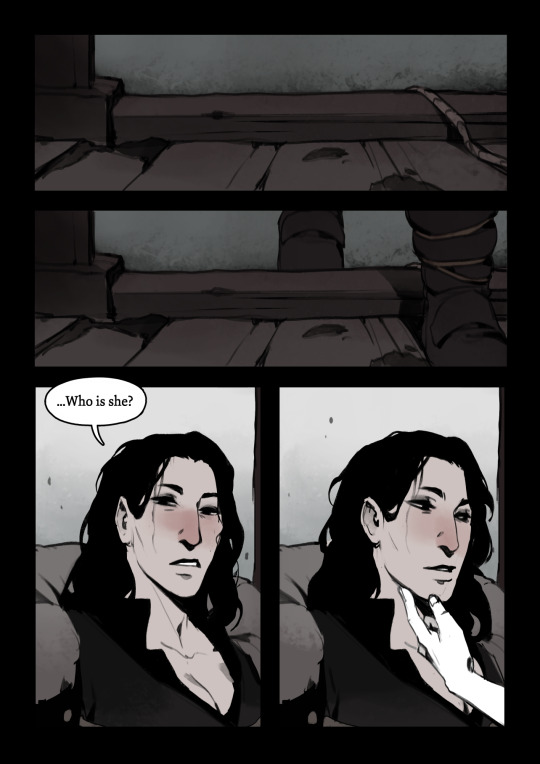
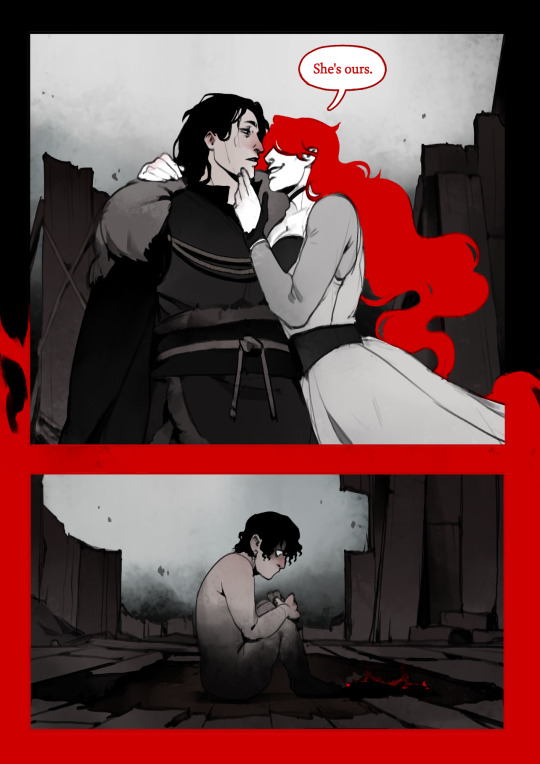
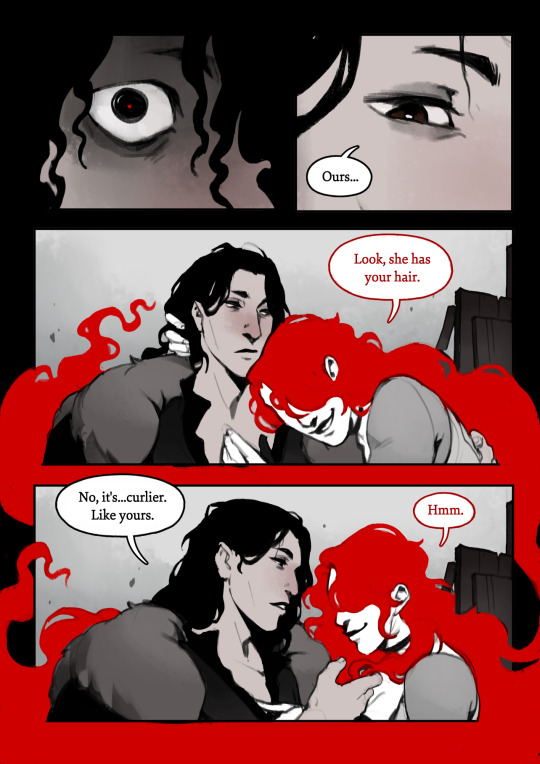
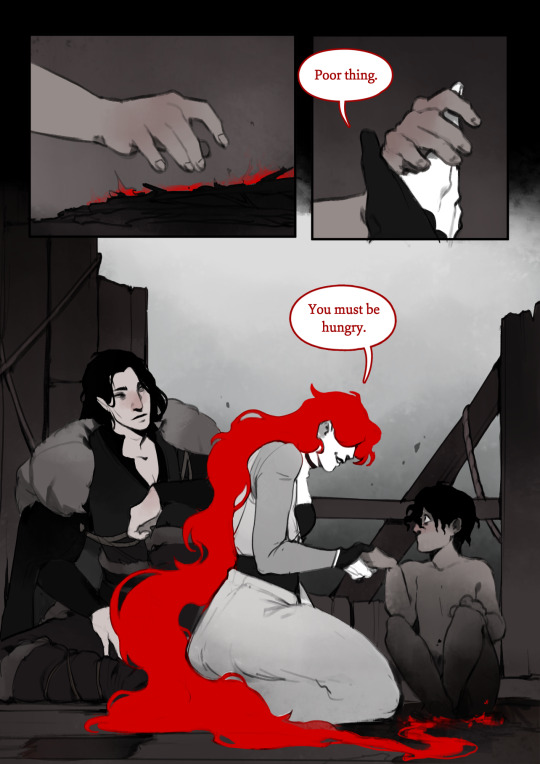
ashes to ashes.
a short comic about the day Ash was born.
Ash's story
Red and Wolf's story
notes:

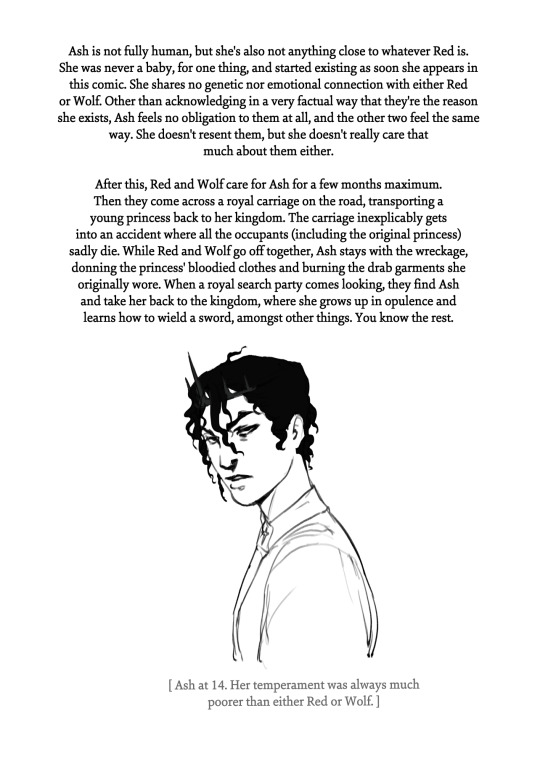
--
all my other comics
store
#we love a family with a storied history of loving women and committing mass murder#wolf is a couple years older than she was in her original comic but still just as smitten with red#i dont intend on making it a habit to connect my comics together into a shared universe#but i did make ash with the internal headcanon that she was the kid of red and wolf#if only to justify elements of her design#the gravity defying hair - the control over fire - the commitment to a black/white/red colour scheme#i wont be doing a backstory for snow btw since she's kind of just. a human being who grew up very entitled and spoiled#although maybe during her undead journey she unknowingly comes across her mothers-in-law in the mountains#(they like to live in remote snowy areas)#red would like her#thats all!#thank you for reading#sapphic art#comic art#stillindigo art#hearteaters#stillindigo comics
3K notes
·
View notes
Text

torture the blond man some more
#cloud strife moogle search history:#how to tell if sword is cursed??#cursed sword what do i do#how to uncurse a sword#trade in cursed sword for normal sword#can swords be haunted by ghosts?#haunted sword#help i think my sword is haunted#how to tell if you're possessed#possessed by haunted sword ghost#can you remove ghost from cursed haunted sword#exorcists in my area#ffvii#cloud strife#my art <3
288 notes
·
View notes
Text


A Blue Painted Shrine is the Latest Discovery in Pompeii ‘Treasure Chest’
Archaeologists have unearthed an intricately decorated blue room, interpreted as an ancient Roman shrine known as a sacrarium, during recent excavations in central Pompeii in Italy.
The Italian Minister of Culture, Gennaro Sangiuliano, visited the site on Tuesday, describing the ancient city as “a treasure chest that is still partly unexplored.”
The blue color found in this new discovery is rare, with the culture ministry outlining that it is generally associated with environments of great decorative importance.
An in-depth analysis of the room, according to the ministry, found that the space could be interpreted as a sacrarium or a space dedicated to ritual activities and the conservation of sacred objects.
The walls of the room feature female figures that are said to depict the four seasons of the year, as well as allegories of agriculture and shepherding.





The new discovery came amid excavations in the Regio IX area of central Pompeii, a residential area that is currently one of the most active excavation sites for new findings.
The excavations are part of a broader project to secure a perimeter between the excavated and non-excavated areas of the archaeological park, which currently has more than 13,000 excavated rooms.
The project aims to improve the structure of the area, making the “protection of the vast Pompeiian heritage… more effective and sustainable,” the culture ministry said.


Other recent findings in the area include furnishings belonging to a house, a bronze kit with two jugs and two lamps, building materials used in renovations, and the shells of oysters that had been consumed.
Last week, it was reported that archaeologists in Pompeii had uncovered children’s sketches depicting violent scenes of gladiators and hunters battling animals.




The drawings, thought to be made by children between the ages of five and seven sometime before Mount Vesuvius erupted in 79 AD, were found on the walls of a back room in the residential sector of the archaeological park.
They showed that even children in ancient times were exposed to extreme violence.
By Antonia Mortensen and Jessie Gretener.


#A Blue Painted Shrine is the Latest Discovery in Pompeii ‘Treasure Chest’#Regio IX area of central Pompei#Mount Vesuvius#sacrarium#roman shrine#roman frescoes#ancient artifacts#archeology#archeolgst#history#history news#ancient history#ancient culture#ancient civilizations#roman history#roman empire#roman art
437 notes
·
View notes
Text
frequently what happens is I'll be drawing a comic and think, huh. I wonder what shoes a 14th/15th century cardinal would wear. I bet they had fancy rules about it, and the answer will be in a 500 page book about the early modern cardinal. I'll think, 'WELLLLLL since I'm already here, I'll check out this other chapter that sounds interesting,' and then I'll find out that the vatican is literally hazardous to your health, but from that point on I'll be locked in for the entire book. I'll start reading through all the citations while checking to see what else some of the contributors have written. the comic has been forgotten entirely because I need to know more about the hats.
#my folder on the knights templar and other military-monastic orders is MASSIVE because i keep spiralling into other areas of#research. same with the cardinals. i will Keep Going until i hit an insurmountable wall#i have like. several books about syphilis in the medieval/renaissance era because i disagreed with something someone said#and then had to follow that up with reading about malaria throughout history#i may have to actually learn latin for this one and. well! if i must. then i will#i wont be happy about it but i'll do it (<<< someone who absolutely does not have to do this in the slightest)
273 notes
·
View notes
Text
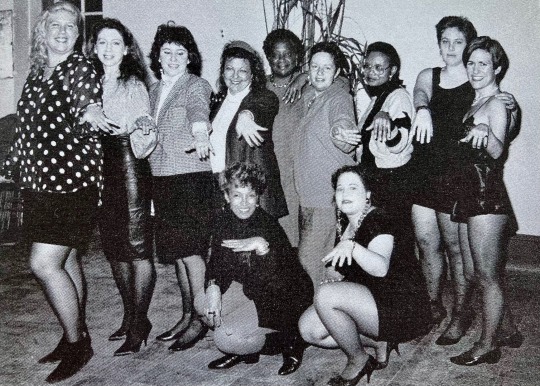
"The New York Femmes, 1991" by Morgan Gwenwald
source: The Persistent Desire: A Femme-Butch Reader, edited by Joan Nestle
#once i get a proper scanner it's over for all of you#unfortunately my printer is SHITE#also unfortunately the way a lot of these books are bound#i'm pretty sure getting a good scan would require taking the binding apart so i can get a clean scan of each pag#and i have found bookbinders in my area#i am admittedly very nervous to take these books apart though at least not without more knowledge#i'll have to ask for the advice and assistance of one of these bookbinders#let them tell me how before i ruin everything ya know#lesbian literature#lesbian#dyke#archived#thatbutcharchivist#femme#femme lesbian#femme dyke#black femme#black femme lesbian#poc femme#lesbian history#black lesbian history#black lesbian#poc lesbian#lesbian books#lesbian photography#author: joan nestle#the persistent desire#year: 1992#publisher: alyson publications inc.#photographer: morgan gwenwald
245 notes
·
View notes
Text
it kinda pisses me off when people dont gaf abt the area(s) they live in. like, youve lived here your whole life and you cant tell me where the cool places to hang are? the tourist traps? the nicest parks? interesting local history and geology? like its so sad to me... even if you find it dull and mundane there is still beauty to be found.....
#i looove ohio geology i could talk about it forever#and i love north carolina flora and fauna soooo much#and i love the geography!!! i love the local histories !!! i love the tourist traps#love the areas you live in !! there is beauty in the small
164 notes
·
View notes
Text
Penelope's weaving
aka I, an archeologist, am here to review the accuracy Penelope's loom in the 2024 movie 'The Return' because I want to avoid thinking about all my papers due next week. For context, I am currently writing my bachelor paper on Minoan textiles, and while I am definitely not an expert, I do know a thing or two about bronze age textile technology
So first point of pedantry: that is not at all a bronze ago loom.

I can't say exactly say what kind of loom this is, as I've only studied bronze ago looms. Whatever kind of horizontal/draw/treadle loom this is, I can confidently state that this would not have been used in Mycenaean times. I'd say that we only see these kinds of looms in Europe from the medieval period, somewhere around the 11th century.
In the bronze age, there are three types of looms in use (as far as we know). The horizontal ground loom, the two beam loom, and the warp-weighted loom. Most traditionally, we see iconography depict Penelope weaving on a warp-weighted loom, like this beautiful vase does.
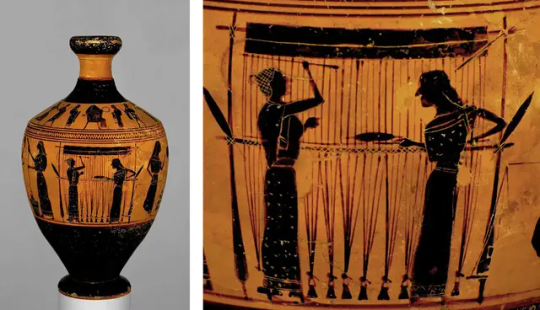
We can clearly recognize this as a warp weighted loom, because we can see the weights: they're the little triangles at the ends of the vertical threads (the warp). The warp-weighted loom is also the only loom we can find archeological remains of, as the loom weights were often made of clay (sometimes pebbles), while the other types of looms were purely wooden.
Furthermore, I have genuinely no clue what she is supposed to be doing with her weaving in this short clip. There is no visible shed, which is the separation between the warp yarns, through which you pull the weft, so that you can actually weave something.

Here's a picture of the shed, as you can see, every other thread is pulled up, and the shed can then be switched around to create a woven pattern.
In the short clip we see, she seems to just be drawing some threads through the warp, which is more than a little nonsensical. If one was weaving a smaller fabric or a tapestry, one could perhaps use a pin or sword beater to pick up individual threads of the warp to pass your horizontal thread (the weft) under, and create patterns that way. That is still not what she is doing here. Additionally, she is weaving a solid red fabric, which would not make it a very interesting tapestry.
Perhaps she's undoing her weaving in this scene? It would make a little more sense if that was what she was doing, as no one would ever be actively weaving at night! It required a lot of light to be able to see what you were doing. Candle light just did not suffice. It still looks a little strange to me, as I don't actually see any woven fabric on the loom that she could be undoing. It's all just loose warp threads.
Honestly, it kind of looks like they picked up a loom from the nearest interactive history museum and plunked it into their movie without doing any research. I think it's a little sad that when adapting a work that centers weaving as much as the Odyssey does, the filmmakers did not do any research into bronze age weaving. You really don't need to be writing a paper on this stuff to find sources for this!
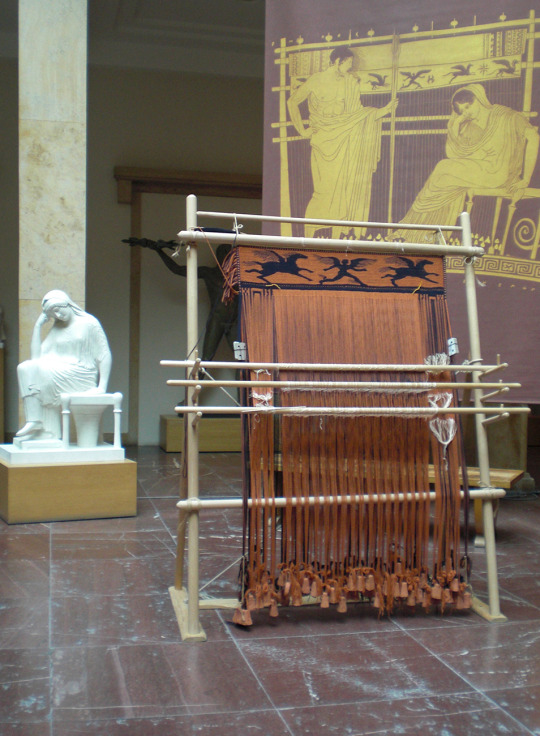
I'll just leave you all with this: a beautiful reconstruction of a warp-weighted loom, with the beginnings of a tapestry as Penelope would have woven it. You can see the loom weights at the bottom, and the sticks in the middle called the heddles, which were used to create the shed I discussed earlier. This is part of the Penelope project.
#archeology#the odyssey#the return#the return 2024#penelope of ithaca#odysseus#if someone knows more about horizontal looms feel free to correct me#theyre definitely out of my area of expertise#i honestly dont really care if movies are historically accurate or not#historical accuracy is in itself an unattainable goal#as even archeologists cannot accurately reconstruct the past#but also#this is just a really obvious mistake#its a little lazy imo#if youre going to adapt a book where weaving is such an important theme#maybe do a quick google search#textile history#additionally i have not watched the movie#only the trailer#so if the movie says anything that contradicts what i said here im sorry#maybe this isnt a loom at all and its a warping frame or something lmao
100 notes
·
View notes
Text
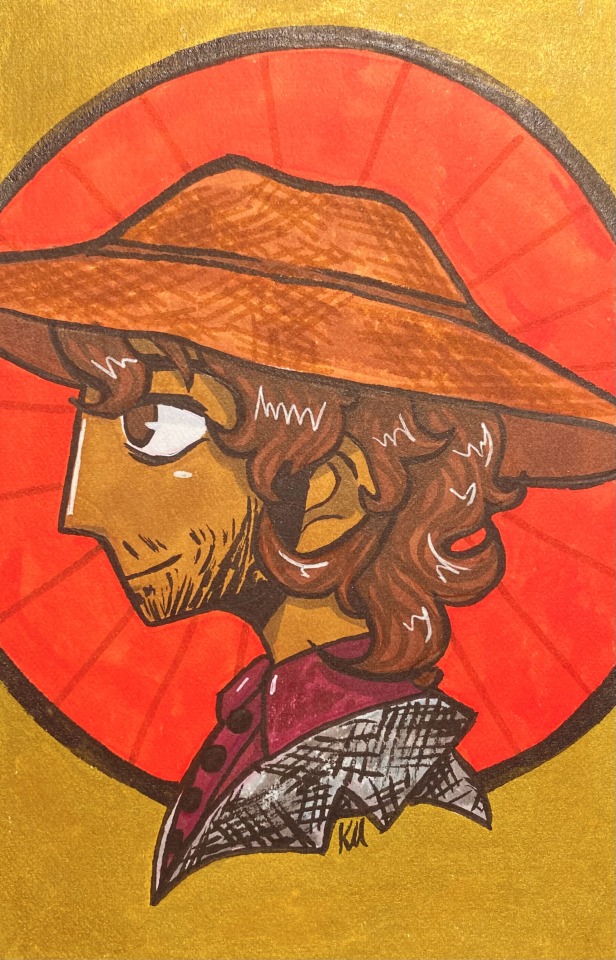
Yeehaw it’s my favourite western character Texas man from British vampire gothic horror by famous Irish guy
#I made this awhile back and was waiting for a big Quincey day to post this but fuck it I love how this turned out#quincey morris#quincey p morris#dracula#dracula daily#re dracula#re: dracula#Art#traditional art#artwork#illustration#markers#alcohol markers#lol I’m actually a huge western enjoyer (but no one else around me is so I basically have no interaction with the genre :( )#I used to find the southwest as a setting boring but then my family dragged me out to Utah and Arizona and something just clicked#Like. Oh. These are beautiful vast areas with a stunning geography and a vibrant history and culture#And out west 110 Fahrenheit feels like 80 Fahrenheit which was crazy to me (I made sure to wear a lot of sun protection)#I also realized I was gay and that played into it
188 notes
·
View notes
Text
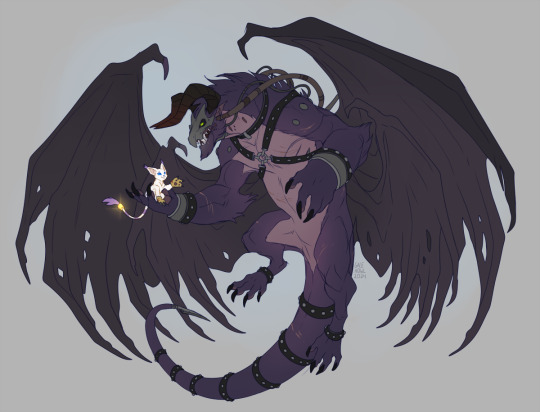
in the darkest night, guiding stars
Some rambling about Tailmon's and Caedemon's complicated relationship in Aurora below~
Tailmon and Caedemon are two of some of the oldest Digimon aligned with both their own and mankind in Aurora, and their relationship goes far back to the very genesis of the Digital World.
As Huanglongmon's creations and members of the Archangels, both of them served them and the four Great Beasts as guardians of their world, alongside the other eight of their kind. For thousands of years, they were the guiding light for all the other Digimon to look up to, until Lucemon's betrayal, and the other six Archangels siding with him. Having discovered what would later become known as the Dark Area - an eldritch, mysterious and volatile dimension existing apart from the Digital and human worlds, yet intertwined with them - he chose to keep it secret, and, in time, his own desires, made worse by the influence of the Area, made him turn against his world and creators. The six others that succumbed to it all the same chose to follow their leader, and nearly laid waste to the Digital World by breaching the dimensional walls and unleashing the Area upon it, but were ultimately stopped by the remaining three Archangels, the world's inhabitants, and Huanglongmon's ultimate sacrifice to seal the Dark Area away, along with the traitors.
Ophanimon perished in those battles, but was reborn in the far future, though without memories of her past.
It was the actions of mankind that called her to action once more, and what awakened Caedemon from his eternal slumber deep within the Dark Area. It was when humans, upon discovering its existence, breached it in an attempt to take control of its powers and Caedemon himself - and sealed the fate of both worlds.
Caedemon, like his brethren, was never meant to be awakened, and Tailmon was mortified upon eventually figuring out the identity of the decaying beast. In her eyes, rightfully, not only was he a traitor, but also even alone a serious danger to both worlds, having become part of the Dark Area itself, but he was also absolutely not fit to be a Tamer's Digimon, especially to a child.
Caedemon initially also did little to soothe her concerns, even with her disdain and suspicions for him obvious, as he exhibited a selfish, troubled and nihilistic personality, caring little for their own kind, and consistently questioning whether or not humanity is even worth saving, with all they've learned about it - a big contrast to her more optimistic outlook on things, a love for all living beings, and a desire to seek out good in everyone, even to the detriment of herself and others.
Though they do eventually mend their once broken friendship, it takes a long time for things to get better, and a lot of change ( namely for Caedemon ) for them to find a way to complement each other in working together - two beings plucked from past long gone - to guide both worlds into a better future.
#I just wanted to say words#all of this is extremely vague LOL#there's so much more to explain about the Dark Area ALONE in this setting not to mention what happens with humans interfering with it#or the full history of the Digital World and what happened and what it's like now#Or how humanity came in contact with Digimon initially#I'm gonna eventually detail things more when I have time to actually work on this and illustrate stuff proper#I haven't even shown any of the human characters' redesigns yet rip#but yes they start out hating each other#very rightfully so for Tailmon#because Caedemon is a fucking asshole initially#and very vague about whether he wants to just destroy everyone or not LOL#she was also the one who defeated him initially when they tried to fuck over the Digital World lmao#ironically their Tamers become best friends very quickly#digimon#my art#my doodles#digimon project: Aurora#Tailmon#Caedemon#Gatomon#demon#Impmon#monster
73 notes
·
View notes
Text
Fic idea: After the end of s2 Ekko starts to cough up blue flowers. Thinking his time is limited since the object of his affections is already dead he decides to travel the world when one day he encounters the very reason for his sickness...
#the timebomb brainrot is real#arcane#arcane season 2#netflix#leage of legends#jinx arcane#powder#timebomb#ekkojinx#ekko#lol#text#crispy#hanahaki#au#promt#fanfiction#someone pls do something with this#i think jinx would be aware that ekko is in the area but only make herself known when she sees him collapse#after a coughing fit#she'd take him somewhere safe and wait until he wakes up before running away again#but Ekko would use the z drive to try and convince her to stay#then she'd learn about his disease and try to pry from him who is the reason#and the more time they spend together the more her jealousy for said unknown person would grow#until ekko is in his deathbed when she's crying over him and confesses her freshly-realized feelings for him#and the rest is history
72 notes
·
View notes
Text
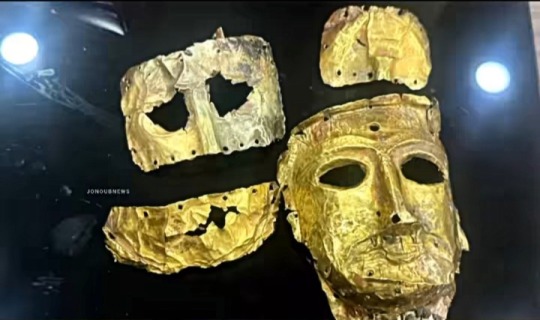
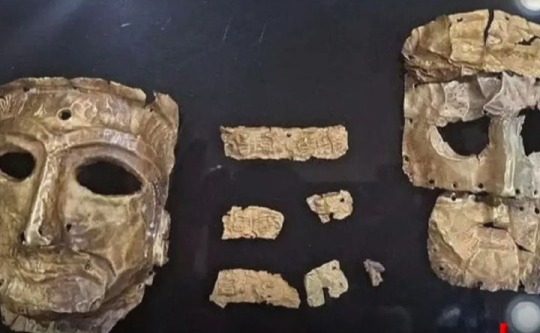
Discovered almost 3 days ago in the south of Iran (shiraz)
Unbelievable! 0_0

According to archaeologists, these objects(two masks and a few piece of bracelet made of gold) are more than 2000 years old and goes back to the pre-Achaemenid empire period and the late Elam area
#treasure#achaemenid#ancient history#history#mask#braclets#treasures#gold#persian empire#kingdom of heaven#fandom#king baldwin iv#area#baldwin iv#kingdom of heaven 2005#the leper king#kingdom of heaven fandom#art#koh fandom#koh#artists on tumblr#old#iran
96 notes
·
View notes
Text

he’s asking if you’re a communist, Robin.
#As a humanities student griffin is so real for this#In my country; the last two years in high school are spent specializing in a subject area of your choice like STEM or humanities or busines#When i was still in middle school i knew these cool humanities students and i was like those young protags who think teenagers are SOO cool#We were having lunch together and then they started talking about communism and looked at me as if i had an opinion#And i��a naive child—stammered out: “b-b-but… isn’t communism…. B a d?”#Then they looked at each other then looked at me and smiled and said the following in reassuring tones:#“Moony in two years you’re going to be gay and a communist”#They weren’t wrong about the first part.#For the second: i’m just anti-capitalist#babel an arcane history#babel#babel rf kuang#Robin swift#griffin lovell#rf kuang
406 notes
·
View notes
Text

X-Planes. Bell X-1-3 being mated with the B-50 Superfortress motherplane in 1951. Colorized image
➤VIDEO: https://youtu.be/FiN7NFsh2oA
#boeing#bell aircraft#X plane#X-Plane#Bell X1#Chuck Yeager#B-50#youtube#aircraft#airplane#aviation#dronescapes#documentary#military#aviation history#area 51
109 notes
·
View notes